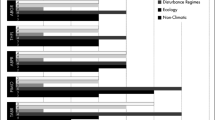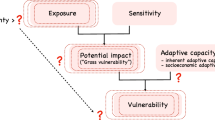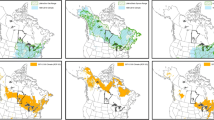Abstract
Climate change is one of several threats that will increase the likelihood that forest tree species could experience population-level extirpation or species-level extinction. Scientists and managers from throughout the United States Forest Service have cooperated to develop a framework for conservation priority-setting assessments of forest tree species. This framework uses trait data and predictions of expected climate change pressure to categorize and prioritize 339 native tree species for conservation, monitoring, management and restoration across all forested lands in the contiguous United States and Alaska. The framework allows for the quantitative grouping of species into vulnerability classes that may require different management and conservation strategies for maintaining the adaptive genetic variation of the species within each group. This categorization is based on risk factors relating to the species’ (1) exposure to climate change, (2) sensitivity to climate change, and (3) capacity to adapt to climate change. We used K-means clustering to group species into seven classes based on these three vulnerability dimensions. The most vulnerable class encompassed 35 species with high scores for all three vulnerability dimensions. These will require the most immediate conservation intervention. A group of 43 species had high exposure and sensitivity, probably requiring conservation assistance, while a group of 69 species had high exposure and low adaptive capacity, probably needing close monitoring. This assessment tool should be valuable for scientists and managers determining which species and populations to target for monitoring efforts and for pro-active gene conservation and management activities.




Similar content being viewed by others
References
Aitken SN, Yeaman S, Holliday JA, Wang TL, Curtis-McLane S (2008) Adaptation, migration or extirpation: climate change outcomes for tree populations. Evol Appl 1(1):95–111. doi:10.1111/j.1752-4571.2007.00013.x
Ally D, Ritland K, Otto SP (2008) Can clone size serve as a proxy for clone age?An exploration using microsatellite divergence in Populus tremuloides. Mol Ecol 17(22):4897–4911. doi:10.1111/j.1365-294X.2008.03962.x
Aubry C, Devine W, Shoal R, Bower A, Miller J, Maggiulli N (2011) Climate change and forest biodiversity: a vulnerability assessment and action plan for national forests in Western Washington, vol 2012. USDA Forest Service, Pacific Northwest Region, Olympia, Washington
Barazani O, Perevolotsky A, Hadas R (2008) A problem of the rich: prioritizing local plant genetic resources for ex situ conservation in Israel. Biol Conserv 141(2):596–600. doi:10.1016/j.biocon.2007.10.014
Bechtold WA, Patterson PL (2005) The enhanced forest inventory and analysis program: national sampling design and estimation procedures. USDA Forest Service, Southern Research Station, Asheville
Black MJ, Bewley JD, Halmer P (2006) The encyclopedia of seeds: science, technology and uses. CAB International, Oxfordshire
Bonner FT, Karrfalt RP (eds) (2008) The woody plant seed manual, vol agricultural handbook no. 727. U.S. Department of Agriculture, Forest Service, Washington, D.C
Bottrill MC, Joseph LN, Carwardine J, Bode M, Cook C, Game ET, Grantham H, Kark S, Linke S, McDonald-Madden E, Pressey RL, Walker S, Wilson KA, Possingham HP (2008) Is conservation triage just smart decision making? Trends Ecol Evol 23(12):649–654. doi:10.1016/j.tree.2008.07.007
Bower AD, St Clair B, Erickson V (2014) Generalized provisional seed zones for native plants. Ecol Appl 24(5):913–919
Bradshaw CJA, Giam XL, Tan HTW, Brook BW, Sodhi NS (2008) Threat or invasive status in legumes is related to opposite extremes of the same ecological and life-history attributes. J Ecol 96(5):869–883. doi:10.1111/j.1365-2745.2008.01408.x
Brook BW, Sodhi NS, Bradshaw CJA (2008) Synergies among extinction drivers under global change. Trends Ecol Evol 23(8):453–460. doi:10.1016/j.tree.2008.03.011
Brown JK, Smith JK (2000) Wildland fire in ecosystems: effects of fire on Flora. United States Department of Agriculture Forest Service, Rocky Mountain Research Station, Ogden
Burgman MA, Keith DA, Walshe TV (1999) Uncertainty in comparative risk analysis for threatened Australian plant species. Risk Anal 19(4):585–598. doi:10.1023/a:1007073301150
Burns RM, Honkala BH (eds) (1990) Silvics of North America: 1. conifers; 2. hardwoods, vol agricultural handbook 654. vol Vol. II. U.S. Department of Agriculture, Forest Service, Washington, D.C
Cain ML, Milligan BG, Strand AE (2000) Long-distance seed dispersal in plant populations. Am J Bot 87(9):1217–1227
Cale JA, Teale SA, West JL, Zhang LJI, Castello DR, Devlin P, Castello JD (2014) A quantitative index of forest structural sustainability. Forests 5(7):1618–1634. doi:10.3390/f5071618
Carter MF, Hunter WC, Pashley DN, Rosenberg KV (2000) Setting conservation priorities for landbirds in the United States: the partners in flight approach. Auk 117(2):541–548. doi:10.1642/0004-8038(2000)117[0541:scpfli]2.0.co;2
Clark JS (1998) Why trees migrate so fast: confronting theory with dispersal biology and the paleorecord. Am Nat 152(2):204–224
Coates DJ, Atkins KA (2001) Priority setting and the conservation of Western Australia’s diverse and highly endemic flora. Biol Conserv 97(2):251–263. doi:10.1016/s0006-3207(00)00123-3
Devine W, Aubry C, Miller J, Potter KM, Bower AD (2012) Climate change and forest trees in the Pacific Northwest: guide to vulnerability assessment methodology. USDA Forest Service, Pacific Northwest Region, Olympia, Washington
Didion M, Fortin MJ, Fall A (2007) Forest age structure as indicator of boreal forest sustainability under alternative management and fire regimes: a landscape level sensitivity analysis. Ecol Model 200(1–2):45–58. doi:10.1016/j.ecolmodel.2006.07.011
Dukes JS, Pontius J, Orwig D, Garnas JR, Rodgers VL, Brazee N, Cooke B, Theoharides KA, Stange EE, Harrington R, Ehrenfeld J, Gurevitch J, Lerdau M, Stinson K, Wick R, Ayres M (2009) Responses of insect pests, pathogens, and invasive plant species to climate change in the forests of northeastern North America: what can we predict? Can J For Res 39(2):231–248. doi:10.1139/x08-171
Dumroese RK, Williams MI, Stanturf JA, Clair JBS (2015) Considerations for restoring temperate forests of tomorrow: forest restoration, assisted migration, and bioengineering. New For 46(5–6):947–964. doi:10.1007/s11056-015-9504-6
Farnsworth EJ (2007) Plant life history traits of rare versus frequent plant taxa of sandplains: implications for research and management trials. Biol Conserv 136(1):44–52. doi:10.1016/j.biocon.2006.10.045
Farnsworth EJ, Klionsky S, Brumback WE, Havens K (2006) A set of simple decision matrices for prioritizing collection of rare plant species for ex situ conservation. Biol Conserv 128(1):1–12. doi:10.1016/j.biocon.2005.09.010
Fischer WC, Miller M, Johnston CM, Smith JK, Simmerman DG, Brown JK (1996) Fire effects information system: user’s guide. USDA Forest Service, Intermountain Research Station, Missoula
Flora of North America Editorial Committee (1993+) Flora of North America North of Mexico. http://floranorthamerica.org/. Accessed 25 June 2013
Foden WB, Butchart SHM, Stuart SN, Vie JC, Akcakaya HR, Angulo A, DeVantier LM, Gutsche A, Turak E, Cao L, Donner SD, Katariya V, Bernard R, Holland RA, Hughes AF, O’Hanlon SE, Garnett ST, Sekercioglu CH, Mace GM (2013) Identifying the world’s most climate change vulnerable species: a systematic trait-based assessment of all birds, amphibians and corals. PLoS ONE. doi:10.1371/journal.pone.0065427
Forest F, Grenyer R, Rouget M, Davies TJ, Cowling RM, Faith DP, Balmford A, Manning JC, Proches S, van der Bank M, Reeves G, Hedderson TAJ, Savolainen V (2007) Preserving the evolutionary potential of floras in biodiversity hotspots. Nature 445(7129):757–760
Friedman SK, Reich PB (2005) Regional legacies of logging: departure from presettlement forest conditions in northern Minnesota. Ecol Appl 15(2):726–744
Gauthier P, Debussche M, Thompson JD (2010) Regional priority setting for rare species based on a method combining three criteria. Biol Conserv 143(6):1501–1509. doi:10.1016/j.biocon.2010.03.032
Giam X, Bradshaw CJA, Tan HTW, Sodhi NS (2010) Future habitat loss and the conservation of plant biodiversity. Biol Conserv 143(7):1594–1602. doi:10.1016/j.biocon.2010.04.019
Global Biodiversity Information Facility (2016) Biodiversity occurrence data. http://www.gbif.org/. Accessed 17 June 2016
Govindaraju DR (1988) Relationship between dispersal ability and levels of gene flow in plants. Oikos 52(1):31–35
Hamrick JL, Godt MJW, Sherman-Broyles SL (1992) Factors influencing levels of genetic diversity in woody plant species. New Forest 6:95–124
Hargrove WW, Hoffman FM (2005) Potential of multivariate quantitative methods for delineation and visualization of ecoregions. Environ Manag 34(Suppl. 1):S39–S60
Hartigan JA (1975) Clustering algorithms. Probability & mathematical statistics. Wiley, New York
Heller NE, Zavaleta ES (2009) Biodiversity management in the face of climate change: a review of 22 years of recommendations. Biol Conserv 142(1):14–32. doi:10.1016/j.biocon.2008.10.006
Hoffmann AA, Sgro CM (2011) Climate change and evolutionary adaptation. Nature 470(7335):479–485. doi:10.1038/nature09670
Intergovernmental Panel on Climate Change (2014) Climate change 2013: the physical science basis. Cambridge University Press, Cambridge
Iverson LR, McKenzie D (2013) Tree-species range shifts in a changing climate: detecting, modeling, assisting. Landsc Ecol 28(5):879–889. doi:10.1007/s10980-013-9885-x
Jimenez-Alfaro B, Colubi A, Gonzalez-Rodriguez G (2010) A comparison of point-scoring procedures for species prioritization and allocation of seed collection resources in a mountain region. Biodivers Conserv 19(13):3667–3684. doi:10.1007/s10531-010-9921-y
Jump AS, Penuelas J (2005) Running to stand still: adaptation and the response of plants to rapid climate change. Ecol Lett 8(9):1010–1020
Lawson SS, Michler CH (2014) Afforestation, restoration and regeneration—not all trees are created equal. J For Res 25(1):3–20. doi:10.1007/s11676-014-0426-5
Littell JS, Oneil EE, McKenzie D, Hicke JA, Lutz JA, Norheim RA, Elsner MM (2010) Forest ecosystems, disturbance, and climatic change in Washington State, USA. Clim Change 102(1–2):129–158. doi:10.1007/s10584-010-9858-x
Logan JA, Regniere J, Powell JA (2003) Assessing the impacts of global warming on forest pest dynamics. Front Ecol Environ 1(3):130–137
Lovett GM, Weiss M, Liebhold AM, Holmes TP, Leung B, Lambert KF, Orwig DA, Campbell FT, Rosenthal J, McCullough DG, Wildova R, Ayres MP, Canham CD, Foster DR, LaDeau SL, Weldy T (2016) Nonnative forest insects and pathogens in the United States: impacts and policy options. Ecol Appl 26(5):1437–1455
Mace GM, Collar NJ (2002) Priority-setting in species conservation. In: Norris K, Pain DJ (eds) Conserving bird biodiversity: general principles and their application. Conservation Biology, vol 7., Cambridge University PressCambridge, United Kingdom, pp 61–73
Mace GM, Possingham HP, Leader-Williams N (2007) Prioritizing choices in conservation. In: Macdonald D, Service K (eds) Key topics in conservation biology. Blackwell Publishing, Oxford, pp 17–34
Manion PD, Griffin DH (2001) Large landscape scale analysis of tree death in the Adirondack Park, New York. For Sci 47(4):542–549
Millar CI, Stephenson NL, Stephens SL (2007) Climate change and forests of the future: managing in the face of uncertainty. Ecol Appl 17(8):2145–2151. doi:10.1890/06-1715.1
Milligan GW, Cooper MC (1985) An examination of procedures for determining the number of clusters in a data set. Psychometrika 50(2):159–179. doi:10.1007/bf02294245
Montréal Process Working Group (2009) Technical notes on implementation of the Montréal process criteria and indicators, criteria 1–7, 3rd edn. Montréal Process Liaison Office. http://www.montrealprocess.org/Resources/Criteria_and_Indicators/index.shtml
Myking T (2002) Evaluating genetic resources of forest trees by means of life history traits—a Norwegian example. Biodivers Conserv 11(9):1681–1696
NatureServe Explorer (2016) An online encyclopedia of life [web application]. Version 7.1 NatureServe. http://www.natureserve.org/explorer. Accessed 15 June, 2016
Pacifici M, Foden WB, Visconti P, Watson JFM, Butchart SHM, Kovacs KM, Scheffers BR, Hole DG, Martin TG, Akcakaya HR, Corlett RT, Huntley B, Bickford D, Carr JA, Hoffmann AA, Midgley GF, Pearce-Kelly P, Pearson RG, Williams SE, Willis SG, Young B, Rondinini C (2015) Assessing species vulnerability to climate change. Nat Clim Change 5(3):215–225. doi:10.1038/nclimate2448
Parmesan C (2006) Ecological and evolutionary responses to recent climate change. Annu Rev Ecol Evol Syst 37:637–669
Parmesan C, Yohe G (2003) A globally coherent fingerprint of climate change impacts across natural systems. Nature 421(6918):37–42
Potter KM, Crane BS (2012) Silviculture and the Assessment of climate change genetic risk for southern appalachian forest tree species. In: Butnor JR (ed) Proceedings of the 16th biennial southern silvicultural research conference (BSSRC), general technical report SRS-156. U.S. Department of Agriculture, Forest Service, Southern Research Station, Asheville, North Carolina, pp 257–258
Potter KM, Hargrove WW (2012) Determining suitable locations for seed transfer under climate change: a global quantitative model. New For 43(5–6):581–599. doi:10.1007/s11056-012-9322-z
Potter KM, Hargrove WH (2013) Quantitative metrics for assessing predicted climate change pressure on North American tree species. Math Comput For Nat-Resour Sci 5(2):151–169
Root TL, Price JT, Hall KR, Schneider SH, Rosenzweig C, Pounds JA (2003) Fingerprints of global warming on wild animals and plants. Nature 421(6918):57–60. doi:10.1038/nature01333
SAS Institute Inc. (2013) The SAS system for Windows, Version 9.4. Cary, North Carolina
Savolainen O, Bokma F, Garcia-Gil R, Komulainen P, Repo T (2004) Genetic variation in cessation of growth and frost hardiness and consequences for adaptation of Pinus sylvestris to climatic changes. For Ecol Manag 197(1–3):79–89
Schmeller DS, Gruber B, Budrys E, Framsted E, Lengyel S, Henle K (2008) National responsibilities in European species conservation: a methodological review. Conserv Biol 22(3):593–601. doi:10.1111/j.1523-1739.2008.00961.x
Sgro CM, Lowe AJ, Hoffmann AA (2011) Building evolutionary resilience for conserving biodiversity under climate change. Evol Appl 4(2):326–337. doi:10.1111/j.1752-4571.2010.00157.x
Sjostrom A, Gross CL (2006) Life-history characters and phylogeny are correlated with extinction risk in the Australian angiosperms. J Biogeogr 33(2):271–290. doi:10.1111/j.1365-2699.2005.01393.x
Smit B, Burton I, Klein RJT, Wandel J (2000) An anatomy of adaptation to climate change and variability. Clim Change 45(1):223–251. doi:10.1023/a:1005661622966
St Clair JB, Howe GT (2011) Strategies for conserving forest genetic resources in the face of climate change. Turk J Bot 35(4):403–409. doi:10.3906/bot-1012-98
Stork NE, Coddington JA, Colwell RK, Chazdon RL, Dick CW, Peres CA, Sloan S, Willis K (2009) Vulnerability and resilience of tropical forest species to land-use change. Conserv Biol 23(6):1438–1447. doi:10.1111/j.1523-1739.2009.01335.x
Sturrock RN, Frankel SJ, Brown AV, Hennon PE, Kliejunas JT, Lewis KJ, Worrall JJ, Woods AJ (2011) Climate change and forest diseases. Plant Pathol 60(1):133–149. doi:10.1111/j.1365-3059.2010.02406.x
Takahashi M, Katano I (2010) Genetic diversity increases regional variation in phenological dates in response to climate change. Glob Change Biol 16(1):373–379. doi:10.1111/j.1365-2486.2009.01993.x
Tan P-N, Steinbach M, Kumar V (2005) Introduction to data mining, 1st edn. Pearson Higher Education, New York
Thomas CD, Cameron A, Green RE, Bakkenes M, Beaumont LJ, Collingham YC, Erasmus BFN, de Siqueira MF, Grainger A, Hannah L, Hughes L, Huntley B, van Jaarsveld AS, Midgley GF, Miles L, Ortega-Huerta MA, Peterson AT, Phillips OL, Williams SE (2004) Extinction risk from climate change. Nature 427(6970):145–148
Thomas CD, Hill JK, Anderson BJ, Bailey S, Beale CM, Bradbury RB, Bulman CR, Crick HQP, Eigenbrod F, Griffiths HM, Kunin WE, Oliver TH, Walmsley CA, Watts K, Worsfold NT, Yardley T (2011) A framework for assessing threats and benefits to species responding to climate change. Methods Ecol Evol 2(2):125–142. doi:10.1111/j.2041-210X.2010.00065.x
Todd CR, Burgman MA (1998) Assessment of threat and conservation priorities under realistic levels of uncertainty and reliability. Conserv Biol 12(5):966–974
United States Department of Agriculture Forest Service (2004) National report on sustainable forests—2003. U.S. Department of Agriculture Forest Service, Washington, D.C.
United States Department of Agriculture Forest Service (2011) National report on sustainable forests—2010. U.S. Department of Agriculture Forest Service, Washington, D.C.
United States Department of Agriculture Forest Service (2016) Fire effects information system. United States Department of Agriculture Forest Service, Rocky Mountain Research Station, Fire Sciences Laboratory. http://www.fs.fed.us/database/feis/. Accessed 17 June 2016
United States Geological Survey (1999) Digital representation of “Atlas of United States Trees” by Elbert L. Little Jr. United States Geological Survey. http://esp.cr.usgs.gov/data/atlas/little/. Accessed 25 June 25
U.S. Department of Agriculture Natural Resource Conservation Service (2016) The PLANTS database. National Plant Data Team. http://plants.usda.gov
Vamosi JC, Vamosi SM (2005) Present day risk of extinction may exacerbate the lower species richness of dioecious clades. Divers Distrib 11(1):25–32
Vittoz P, Engler R (2007) Seed dispersal distances: a typology based on dispersal modes and plant traits. Bot Helv 117(2):109–124. doi:10.1007/s00035-007-0797-8
Williams SE, Shoo LP, Isaac JL, Hoffmann AA, Langham G (2008) Towards an integrated framework for assessing the vulnerability of species to climate change. PLoS Biol 6(12):2621–2626. doi:10.1371/journal.pbio.0060325
Willis SG, Foden W, Baker DJ, Belle E, Burgess ND, Carr JA, Doswald N, Garcia RA, Hartley A, Hof C, Newbold T, Rahbek C, Smith RJ, Visconti P, Young BE, Butchart SHM (2015) Integrating climate change vulnerability assessments from species distribution models and trait-based approaches. Biol Conserv 190:167–178. doi:10.1016/j.biocon.2015.05.001
Woodall CW, Oswalt CM, Westfall JA, Perry CH, Nelson MD, Finley AO (2009) An indicator of tree migration in forests of the eastern United States. For Ecol Manag 257(5):1434–1444. doi:10.1016/j.foreco.2008.12.013
Woudenberg SW, Conkling BL, O’Connell BM, LaPoint EB, Turner JA, Waddell KL (2010) The forest inventory and analysis database: database description and users manual version 4.0 for phase 2. USDA Forest Service, Rocky Mountain Research Station, Fort Collins, Colorado
Yanchuk AD, Lester DT (1996) Setting priorities for conservation of the conifer genetic resources of British Columbia. For Chron 72(4):406–415
Zhu K, Woodall CW, Clark JS (2012) Failure to migrate: lack of tree range expansion in response to climate change. Glob Change Biol 18(3):1042–1052. doi:10.1111/j.1365-2486.2011.02571.x
Acknowledgements
We thank Julie Canavin, Maria Eugenia Escanferla, Brunell Gugelmann, Ana Castillo and Ti’Era Worsley for their work collecting and tabulating much of the species trait data used in this assessment. We appreciate the advice and discussion of Carol Aubry, Andy Bower, Warren Devine, Frank Koch, Kurt Riitters, and Mark Ambrose. We also thank Gary Man and Danny Lee for coordinating the funding of this project, to Jim Fox for facilitating the workshop, and to the members of the workshop planning committee (Jim Fox, David Gwaze, Valerie Hipkins, Randy Johnson, Gary Man, David Peterson, and Keith Woeste) and to the other workshop participants (Paul Berrang, Tom Blush, Barry Bollenbacher, Andy Bower, William Carromero, Gregg DeNitto, Don Duerr, Craig Echt, Vicky Erickson, Brian Jackson, Danny Lee, Mary Frances Maholovich, Rob Mangold, Ron Overton, David Pivorunas, Claudia Regan, Barb Schrader, Richard Sniezko, Brad St. Clair, and Jim Youtz). This work was supported by in part through Research Joint Venture Agreement 13-JV-11330110-072 between the U.S. Department of Agriculture, Forest Service, Southern Research Station, and North Carolina State University.
Author information
Authors and Affiliations
Corresponding author
Electronic supplementary material
Below is the link to the electronic supplementary material.
Rights and permissions
About this article
Cite this article
Potter, K.M., Crane, B.S. & Hargrove, W.W. A United States national prioritization framework for tree species vulnerability to climate change. New Forests 48, 275–300 (2017). https://doi.org/10.1007/s11056-017-9569-5
Received:
Accepted:
Published:
Issue Date:
DOI: https://doi.org/10.1007/s11056-017-9569-5




